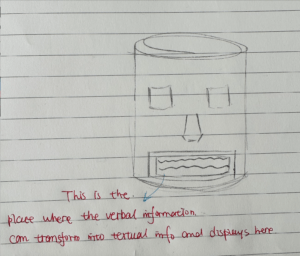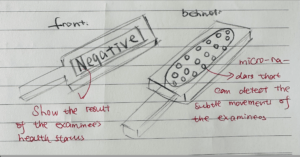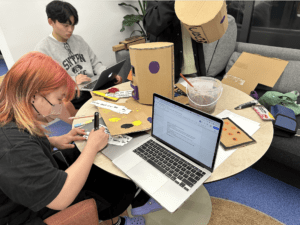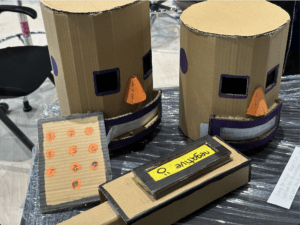Interaction Lab Group Performance Blog
Section 1: Idea Forming & Sketching
We chose the story “The Plague” by Yan Leisheng as our background story. The character “crow” left me with a deep impression when I first read this fiction. They wear all-black airtight protective suits and vigilantly “eliminate” the so-called infectious people. The features of the protective suits, which are airtight, heavy, and self-isolated, make me think of the problem of communication in that special circumstance. The protective suits serve as a physical barrier between people, making it harder for people to communicate with each other. Especially the elders and disabled people, who may suffer from hearing loss, the protective suits may completely cut off their communication with the outside world. Hence, my initial question derived from my idea is that “How can we design a device that can help those people suffering from hearing loss communicate with other people during the plague?”
After our group’s discussion, we came up with the idea of making a “caption helmet”, which can transform people’s verbal information into textual information. The textual information can be further projected on the surface of the helmet. Having our initial idea, we began to sketch it out. Since we’re going to carry out our idea by cardboard-making, we designed the helmet in a column shape with the caption area in front of the user’s mouth. The reason why we design the caption area as a “mouth” is that people suffering from hearing loss may habitually look at people’s mouths when talking to capture the signals of lips’ movements. Here is the initial sketch of our caption helmet.

Besides the caption helmet, we also discussed the detection of the disease. In fiction, the crows merely diagnose infectious people by looking at whether they can move or not, which is not accurate at all. Hence, we additionally design another device that can detect subtle movements of the examinees, including physical movements and heartbeats. We designed the detection machine in a handheld shape. There is a screen in front of the machine which can tell whether the examinee is infected or not. Behind the machine, there are many micro-radar transmitters that can detect every subtle movement of the examinee to accurately tell whether he/she is infected or not. Here below is our sketch for this detection machine.

Section 2: Making & Critical Assessment
There are five members in my group. We divided our group into two subgroups — one for artifact making and one for script writing. For artifact making, we plan to make two helmets and one detection machine. We utilized the packing boxes we left during the winter vacation move-out to make the prototypes of our artifacts. Here is a picture showing our making process. I personally in charge of script writing. I made up story among two crows (epidemic prevention personnel), an old man suffering from hearing loss and his vegetable son. Two crows firstly misidentify the old man’s vegetable son as infected because of the miscommunication between crows and the old man. But if the two crows put on the caption helmet and use the detection machine, the tragedy won’t happen. Here’s the full script:
https://docs.google.com/document/d/1Rgx0bqIq-OYIn-1_3dx1hkin0ovpDoO7B43Toa6Ns1g/edit?usp=sharing


As for the advantages of our artifacts, I think the caption helmet is really pragmatic and helpful for those people suffering from hearing loss. The technology applied in making caption helmet is not really out of reach, so it may be come true one day. However, the non-transparent appearance of the helmet blocks the user’s expressions, which may decrease the efficiency of communication. Also, the hermetic design makes it hard for the user to breathe. Maybe we can consider use the breathable material instead of cardbox. The detection machine is also pretty practical and useful during the plague pandemic. However, the implementation of micro-radar transmitter makes it difficult to carry out in reality.
Here below is our full performance. Hope you enjoy it!
https://drive.google.com/file/d/1rvJn6sQZMQYuOFhsSKILyhepoohX_SCB/view?usp=share_link
Section 3: Comments on “Mirror” Group’s Performance
Their performance is based on the fiction “The Ones Who Walk Away from Omelas” by Ursula K. Le Guin. Their artifact is a mirror, which can tell whether people are happy from inner heart or not. First of all, I have to say that I really love their performance – dramatic and fun. They explicitly demonstrate the idea of their artifacts through their performance. The theme of “true happiness” fits the fiction’s topic. The mirror is also a perfect artifact to fit make under the context of the fiction, since the mirror represents “reflection” metaphorically. However, I expect more explanation on the mechanism behind the mirror’s function — how can it reflect the “true” self of people? Overall, it’s a wonderful performance. I enjoyed it a lot!